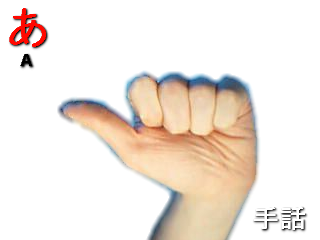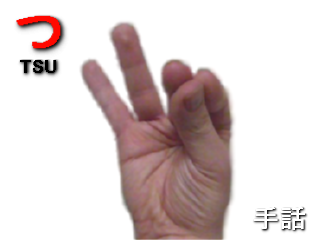|
Yubimoji
The is a system of manual ''kana'' used as part of Japanese Sign Language (JSL). It is a signary of 45 signs and 4 diacritics representing the phonetic syllables of the Japanese language. Signs are distinguished both in the direction they point, and in whether the palm faces the viewer or the signer. For example, the manual syllables ''na, ni, ha'' are all made with the first two fingers of the hand extended straight, but for ''na'' the fingers point down, for ''ni'' across the body, and for ''ha'' toward the viewer. The signs for ''te'' and ''ho'' are both an open flat hand, but in ''te'' the palm faces the viewer, and in ''ho'' it faces away. Although a syllabary rather than an alphabet, manual kana is based on the manual alphabet of American Sign Language. The simple vowels ''a, i, u, e, o'' are nearly identical to the ASL vowels, while the ASL consonants ''k, s, t, n, h, m, y, r, w'' are used for the corresponding syllables ending in the vowel ''a'' in manual kana: ''ka, sa, ta ... [...More Info...] [...Related Items...] OR: [Wikipedia] [Google] [Baidu] |
Japanese Sign Language
, also known by the acronym JSL, is the dominant sign language in Japan and is a complete natural language, distinct from but influenced by the spoken Japanese language. Population There are 304,000 Deaf and Hard of Hearing people who are above age 18 in Japan (2008). However, there is no specific source about the number of JSL users because of the difficulty in distinguishing who are JSL users and who use other kinds of sign, like and . According to the Japanese Association for Sign Language Studies, the estimated number of JSL users is around 60,000 in Japan. History Little is known about sign language and the deaf community before the Edo period. In 1862, the Tokugawa shogunate dispatched envoys to various European schools for the deaf but the first school for the deaf was not established until 1878 in Kyōto. It was founded by Tashiro Furukawa, who also developed what would become JSL. Until 1948, deaf children were not required to attend school or to receive a formal e ... [...More Info...] [...Related Items...] OR: [Wikipedia] [Google] [Baidu] |
Syllabary
In the Linguistics, linguistic study of Written language, written languages, a syllabary is a set of grapheme, written symbols that represent the syllables or (more frequently) mora (linguistics), morae which make up words. A symbol in a syllabary, called a syllabogram, typically represents an (optional) consonant sound (simple onset (linguistics), onset) followed by a vowel sound (nucleus (syllable), nucleus)—that is, a CV (consonant+vowel) or V syllable—but other phonogram (linguistics), phonographic mappings, such as CVC, CV- tone, and C (normally nasals at the end of syllables), are also found in syllabaries. Types A writing system using a syllabary is ''complete'' when it covers all syllables in the corresponding spoken language without requiring complex orthography, orthographic / graphemic rules, like implicit codas ( ⇒ /C1VC2/), silent vowels ( ⇒ /C1V1C2/) or echo vowels ( ⇒ /C1V1C2/). This loosely corresponds to ''shallow'' orthographies in alphabetic writin ... [...More Info...] [...Related Items...] OR: [Wikipedia] [Google] [Baidu] |


